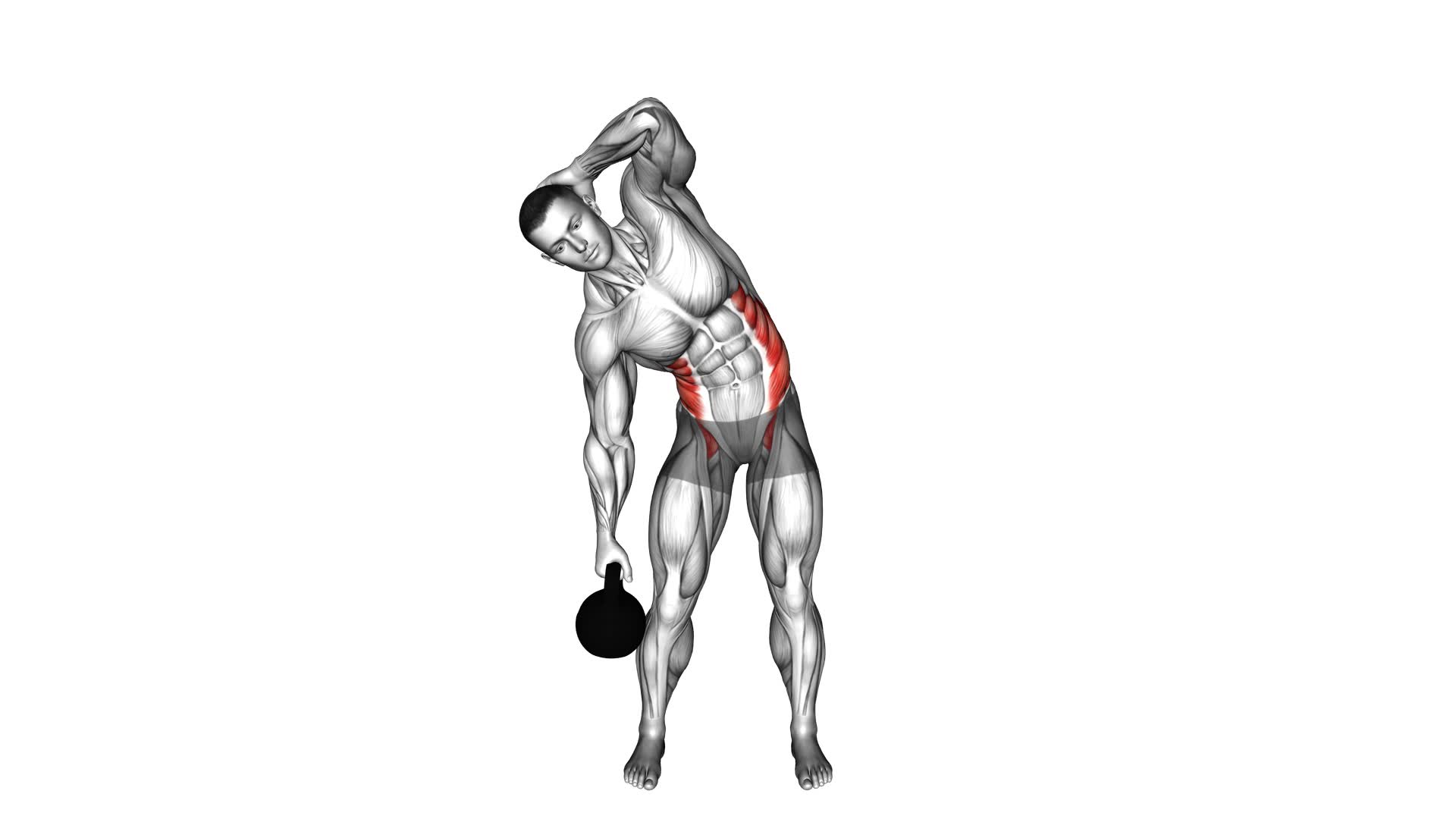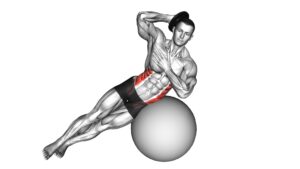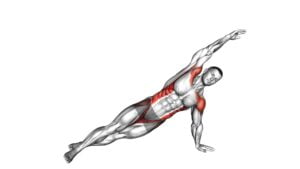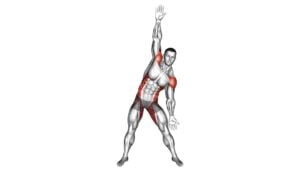Kettlebell Side Bend – Video Exercise Guide & Tips

Looking to tone your obliques and strengthen your core? The Kettlebell Side Bend is the perfect exercise for you.
Watch This Exercise Video
In this video exercise guide, we'll show you the proper form and technique, as well as provide tips to maximize your results.
Don't worry about choosing the right kettlebell weight or making common mistakes – we've got you covered.
Get ready to feel the burn and achieve your fitness goals with this effective exercise.
Key Takeaways
- Targets and strengthens oblique muscles
- Improves posture and functional strength
- Engages muscles of lower back, hips, and glutes
- Promotes better balance and stability
Benefits of the Kettlebell Side Bend
One major benefit of the Kettlebell Side Bend is that it targets and strengthens your oblique muscles. The oblique muscles are located on the sides of your abdomen and play a crucial role in stabilizing your core and supporting your spine. By performing the Kettlebell Side Bend, you can effectively engage and tone these muscles, leading to improved posture and enhanced functional strength.
In addition to targeting the obliques, the Kettlebell Side Bend also provides several other benefits. It helps to improve your overall core strength, as it engages not only the obliques but also the muscles of your lower back, hips, and glutes. This exercise also promotes better balance and stability, as you have to control the weight of the kettlebell while bending to the side.
To perform the Kettlebell Side Bend with proper technique, start by standing with your feet shoulder-width apart and holding a kettlebell in one hand. Keep your back straight and your core engaged as you slowly lower the kettlebell towards the side of your leg, focusing on the stretch in your oblique muscles. Return to the starting position and repeat on the other side.
Proper Form and Technique for the Exercise
To perform the Kettlebell Side Bend with proper form and technique, you should focus on maintaining a straight back, engaging your core, and controlling the kettlebell as you lower it towards the side of your leg. Here are some tips to help you achieve the proper form and alignment:
- Common Errors:
- Avoid rounding your back or hunching your shoulders. This can put unnecessary strain on your spine and lead to injury.
- Don't use excessive weight. Start with a lighter kettlebell and gradually increase the load as your strength improves. Using too heavy of a weight can compromise your form and increase the risk of injury.
- Proper Alignment:
- Stand with your feet shoulder-width apart and your knees slightly bent. This will provide a stable base of support.
- Hold the kettlebell in one hand, keeping your arm extended down by your side.
- Engage your core muscles by drawing your belly button towards your spine.
- Slowly lower the kettlebell towards the side of your leg, maintaining a straight back throughout the movement.
- Return to the starting position by using your core muscles to lift the kettlebell back up.
Choosing the Right Kettlebell Weight
To choose the right kettlebell weight, focus on finding a weight that challenges you without compromising your form or risking injury. Kettlebell training offers a wide range of benefits, including increased strength, improved cardiovascular fitness, enhanced flexibility, and improved body composition. Incorporating kettlebell exercises into your workout routine is a great way to add variety and intensity.
Here are some tips to help you incorporate kettlebell exercises effectively:
- Start with a weight that allows you to perform the exercise with proper form. It's better to start lighter and gradually increase the weight as you become more comfortable and confident.
- Consider your fitness level and goals. If you're a beginner, start with a lighter weight and focus on mastering the basic movements. If you're more advanced, you can challenge yourself with a heavier weight to continue progressing.
- Listen to your body. Pay attention to how your muscles feel during and after the exercise. If you're experiencing pain or discomfort, it may be a sign that you're using too heavy of a weight.
- Seek guidance from a certified kettlebell instructor. They can help assess your form and recommend the appropriate weight for your level.
Common Mistakes to Avoid
Avoid making these common mistakes when performing the kettlebell side bend exercise. To ensure a safe and effective workout, it's crucial to avoid the following errors:
- Using too heavy a weight: Using a kettlebell that's too heavy can strain your muscles and increase the risk of injury. Start with a lighter weight and gradually increase it as you become more comfortable and confident with the exercise.
- Neglecting proper form: Maintaining proper form is essential to avoid injuries and maximize the benefits of the kettlebell side bend. Keep your back straight, engage your core, and avoid leaning too far to one side. Focus on maintaining proper alignment throughout the movement.
- Forgetting to breathe: Proper breathing technique is often overlooked but is crucial during any exercise. Inhale deeply before beginning the movement, and exhale as you bend sideways. This helps stabilize your core and maintain control throughout the exercise.
- Rushing through the exercise: Slow and controlled movements are key to reaping the full benefits of the kettlebell side bend. Avoid rushing through the exercise, as it can compromise your form and increase the risk of injury. Take your time and focus on engaging the targeted muscles with each repetition.
Variations and Progressions to Try
As you progress in your kettlebell side bend workout, there are various variations and progressions you can try to challenge your muscles and enhance your overall strength and stability.
These progression options will help you continue to see improvements in your muscle activation and overall fitness.
One option to consider is increasing the weight of the kettlebell. By gradually increasing the weight, you'll challenge your muscles even more and continue to build strength. Start with a weight that feels challenging but manageable, and gradually increase it as you get stronger.
Another progression to try is incorporating a twist into the movement. As you lower the kettlebell towards your side, rotate your torso towards the opposite side. This will engage your obliques even more and add an additional challenge to the exercise.
You can also experiment with different tempos. Slow down the movement to increase time under tension and really focus on the muscles being worked. Or, try performing the side bend exercise explosively to improve power and athleticism.
Remember to always maintain proper form and listen to your body. It's important to progress gradually and not push yourself too hard too soon.
Tips for Maximizing Your Results
To maximize your results in your kettlebell side bend workout, focus on maintaining proper form and gradually increasing the intensity of your exercises. Here are some tips to help you get the most out of your workout:
- Stay consistent: Consistency is key when it comes to seeing results. Make sure to incorporate the kettlebell side bend into your regular workout routine at least two to three times a week.
- Progress gradually: Start with a lighter kettlebell and gradually increase the weight as your strength improves. This will help you maximize the intensity of your workout over time.
- Engage your core: The kettlebell side bend primarily targets the obliques, but you can enhance the effectiveness of the exercise by engaging your core muscles throughout the movement. This will help you maintain stability and control.
- Incorporate other exercises: While the kettlebell side bend is a great exercise on its own, incorporating it into a full body workout can further maximize your results. Combine it with exercises like squats, lunges, and push-ups to work multiple muscle groups and burn more calories.
Frequently Asked Questions
How Many Repetitions of the Kettlebell Side Bend Should I Do?
To determine how many repetitions of the kettlebell side bend you should do, consider your workout intensity and proper form. The kettlebell side bend is an effective exercise for targeting your obliques. Start with a weight that challenges you but allows you to maintain proper form throughout the movement.
Aim for 8-12 repetitions on each side, gradually increasing as you get stronger. Remember to listen to your body and make adjustments as needed.
Can the Kettlebell Side Bend Help With Reducing Love Handles?
The kettlebell side bend can be beneficial for reducing love handles. By targeting the oblique muscles, this exercise helps to strengthen and tone the waist area.
However, it's important to note that spot reduction isn't possible, meaning that doing only this exercise won't solely eliminate love handles.
Incorporating other exercises like planks, Russian twists, and bicycle crunches can also help in reducing love handles by engaging multiple muscles in the core area.
Is the Kettlebell Side Bend Suitable for Beginners?
The kettlebell side bend is a great exercise for targeting your obliques and core muscles. It's important to note that it may not be suitable for beginners due to its advanced nature and potential for injury if performed incorrectly.
However, there are beginner modifications available, such as using lighter weights or performing the exercise without any weights at all.
Alternatively, there are other exercises that can help beginners strengthen their core, such as Russian twists or bicycle crunches.
Can I Do the Kettlebell Side Bend if I Have Lower Back Pain?
If you have lower back pain, it's important to be cautious when doing kettlebell exercises. The kettlebell side bend can put strain on your lower back, so it may not be suitable for you.
It's best to consult with a healthcare professional or a certified trainer who can assess your condition and recommend exercises that are safe and effective for your specific situation.
How Long Should I Rest Between Sets of the Kettlebell Side Bend?
To ensure you get the most out of your kettlebell side bend workout, it's important to know how long to rest between sets. Rest duration will depend on your fitness level and goals, but a good rule of thumb is to rest for about 30-60 seconds between sets.
This allows your muscles to recover and maintain proper form throughout the exercise. Remember to listen to your body and adjust the rest time as needed.
Conclusion
In conclusion, the kettlebell side bend is a highly effective exercise for targeting and strengthening the oblique muscles.
By maintaining proper form and choosing the right kettlebell weight, you can maximize the benefits of this exercise and avoid common mistakes.
Additionally, by incorporating variations and progressions, you can continuously challenge your muscles and improve your overall strength and stability.
Remember to follow these tips and stay consistent to achieve optimal results from your kettlebell side bend workouts.

Author
Years ago, the spark of my life’s passion ignited in my mind the moment I stepped into the local gym for the first time. The inaugural bead of perspiration, the initial endeavor, the very first surge of endorphins, and a sense of pride that washed over me post-workout marked the beginning of my deep-seated interest in strength sports, fitness, and sports nutrition. This very curiosity blossomed rapidly into a profound fascination, propelling me to earn a Master’s degree in Physical Education from the Academy of Physical Education in Krakow, followed by a Sports Manager diploma from the Jagiellonian University. My journey of growth led me to gain more specialized qualifications, such as being a certified personal trainer with a focus on sports dietetics, a lifeguard, and an instructor for wellness and corrective gymnastics. Theoretical knowledge paired seamlessly with practical experience, reinforcing my belief that the transformation of individuals under my guidance was also a reflection of my personal growth. This belief holds true even today. Each day, I strive to push the boundaries and explore new realms. These realms gently elevate me to greater heights. The unique combination of passion for my field and the continuous quest for growth fuels my drive to break new ground.







